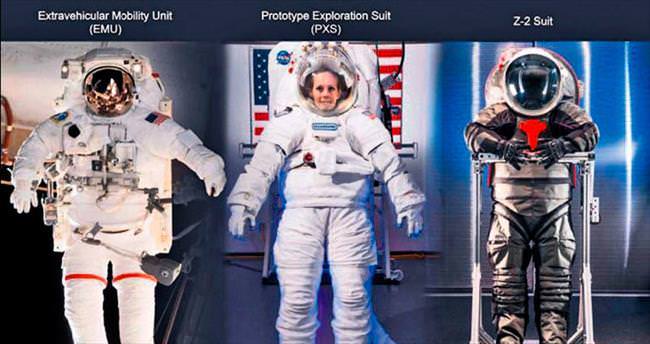Part 2 of 2 Parts (Please read Part 1 first)
NASA’s current EVA suit weights about twenty-seven and a half pounds. It has fourteen layers of special material to protect the astronaut from conditions in space. It comes in medium, large and extra-large sizes. A poor fit may result in shoulder injuries for the astronaut. The EVA suits have four point three pounds per square inch internal pressure with a pure oxygen air supply. In order to prepare for leaving the spacecraft, an astronaut has to spend up to four hours in the suit “pre-breathing” and adapting to the suit environment.
No one has walked on the surface of the Moon since two astronauts got into A7-LB pressure suits during the Apollo lunar mission in 1972. It turned out that the A7-LB suits deteriorated rapidly in the lunar environment. The surviving Apollo suits are now considered to be museum pieces.
NASA does have a prototype next generation spacesuit called the Z-2. This suit contains some of the design elements of the old EVA suits, but it is lighter and more flexible. Some critics say that NASA has fallen behind in the design of spacesuits and private contractors are stepping up.
Dava Newman used to work at NASA but is now designing spacesuits at MIT. She and her team are working on a new type of form-fitting spacesuit. Unlike the old EVA suits that employed a pressurized internal gas atmosphere, the new suits will utilize mechanical pressure directly applied to the astronaut’s body. The Newman suit is lighter than the old EVA suits and is tailored to each individual astronaut. NASA has not reached out to private contractors yet for new spacesuits but Newman wants to have her design ready, just in case.
Pablo de Leon is a spacesuit designer and a professor at University of North Dakota. He has is own design ideas for a new spacesuit. The new suits should be lighter, more flexible and easier to put on and take off. He thinks that the atmosphere is a spacecraft should be reduced from fourteen point seven pounds per square inch to eight pounds. If this change is made, less “pre-breathing” time will be necessary. One of his main concerns is the use of bearing in the joints of the spacesuit. Both the Moon and Mars are dusty environments that would wear out bearings.
Delays in creating new spacesuits could lead to a crisis as early as 2024. That is the date that the Trump administration has set for withdrawing from the ISS program. Even in the best circumstances, the Lunar Gateway station will still be under construction in 2024. It would be better for NASA to research and develop a new spacesuit design before 2024 because after that date it will be difficult to test them in space without a space station.
Material science is moving quickly. New fabrics and films with novel properties are being developed. New materials will soon be available for incorporation into spacesuits. They will make spacesuits tougher, more flexible and safer. In addition, they will change some design features in ways that cannot be anticipated at present.
